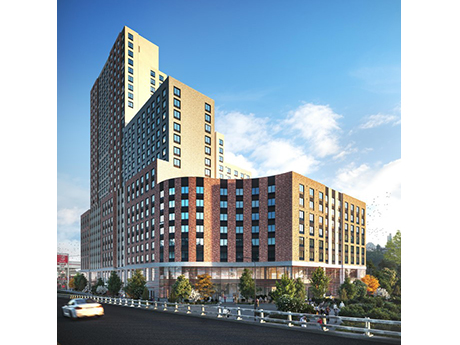By Jason Penighetti, Esq., and Carol Rizzo, Esq. of Forchelli Deegan Terrana
Together with high rent and exorbitant property values, the real property taxes that fund necessary services in New York State make housing affordability a significant concern for low- and middle-income residents. To ensure a sufficient supply of affordable housing, the state must address the ad valorem levy, whereby taxes are derived from a property’s market value.
This article examines the critical interplay between New York’s property tax policies and housing affordability. While some taxing mechanisms hinder the development and availability of affordable housing, adjustments and a few additions to those practices have the potential to promote the affordable sector.

Jason Penighetti,
Forchelli Deegan Terrana
Exemptions, Incentives
New York’s real property tax system supports a complex framework of entities that rely significantly upon property tax levies to generate revenue and fund their budgets. Property taxes, assessed at the local level, support essential services such as public schools, police departments, libraries, highways, fire districts, open space preservation, out-of-county college tuition and the New York State Metropolitan Transportation Authority, among others.
To encourage the development of affordable housing and ease the burden that real property taxes can impose on developers and owners in the sector, New York offers several tax exemptions and incentive programs. Availability and benefits for some of the programs vary depending on a project’s location.
One such option for developers is the 421-a Tax Incentive Program, also known as the Affordable New York Housing Program. Aimed at developers of new-construction, multi-unit housing, the program can provide full property tax exemptions during construction, followed by a graduated phase-in to normal taxation once the project is completed. In return, applicants must reserve a portion of the units to rent at affordable rates.

Carol Rizzo,
Forchelli Deegan Terrana
Another option, originally enacted by the federal Tax Reform Act of 1986, involves Low-Income Housing Tax Credits. This program gives state and local agencies the authority to issue tax credits for the acquisition, rehabilitation or new construction of rental housing targeted to lower-income households. Developers receiving these credits can then sell them to investors, generating equity for the project and reducing their need for debt financing. While this may not be a direct property tax exemption, it can significantly promote the financial feasibility of affordable housing developments.
A third initiative was created by The Housing Trust Fund Corp. as a subsidiary public benefit corporation of the New York State Housing Finance Agency. It provides funding to eligible applicants to construct low-income housing or to rehabilitate vacant, distressed or underutilized residential or nonresidential property to residential use for occupancy by low-income individuals. These funds often come with property tax exemptions or abatements, reducing operating costs for affordable housing providers.
In addition to these broad exemptions, individual homeowners may qualify to ease high property tax costs via incentives such as the School Tax Relief Exemption or exemptions for senior citizens, veterans, people with disabilities, clergy and certain agricultural properties, among others. A property tax professional can help developers or homeowners determine what programs are available to reduce the tax burden for their property.
Challenges, Criticisms
Despite the evident benefits these programs bring to communities, critics argue that property tax exemptions can create inequities in the tax system.
Large developers might benefit disproportionately from programs like 421-a, for example, while smaller property owners bear a more significant tax burden. Additionally, critics argue that tax-abatement-based programs fail to address other challenges that impede the creation of new affordable housing. Affluent neighborhoods, for instance, often resist new affordable housing projects, thwarting development efforts and perpetuating socioeconomic divides.
Administering property tax exemptions and deciphering potential incentives can be complex and burdensome. Developers must navigate convoluted application processes and compliance requirements, which can delay projects and increase costs.
Local governments also face challenges in ensuring proper implementation and monitoring of these programs. Real or perceived complexities associated with application processes for permitting, financing and incentives often constitute a barrier in themselves, discouraging developers from undertaking new affordable housing projects.
Ongoing underserved renter demand for affordable housing suggests the current assortment of incentives is failing to achieve the desired outcome, which is to ensure an adequate supply of affordable housing. Rising construction costs, limited availability of suitable land and community opposition exacerbate this imbalance, resulting in a persistent gap between the number of affordable units needed and those available.
A Call to Action
New York lawmakers have the opportunity to boost affordable housing efforts by enhancing the effectiveness of property tax policies that promote the sector. Simplifying the application and compliance processes for tax incentives would be a significant first step that would encourage more developers to participate.
Following on the theme of simplification, the state should consider creating a centralized information hub with dedicated support for all development incentives. This would give developers a single resource to help them navigate the bureaucratic landscape and complete new affordable projects successfully.
Answering the call for more affordable housing will require more than tax abatements, however. Leaders must find ways to increase funding for affordable housing programs. Additionally, offering low-interest loans, grants and technical assistance to nonprofit developers would enhance their capacity to deliver affordable units.
New York State’s real property tax system plays a crucial role in shaping the affordable housing landscape. While current tax exemptions and incentive programs provide some essential support, challenges remain in achieving equity, efficiency and adequate supply. By refining these policies and addressing systemic issues, New York should be able to make significant strides toward ensuring that affordable housing is accessible to all its residents.
— Jason Penighetti and Carol Rizzo are partners at the Uniondale, New York, office of law firm Forchelli Deegan Terrana, the New York State member of American Property Tax Counsel, the national affiliation of property tax attorneys. Jason can be reached at jpenighetti@forchellilaw.com, and Carol can be reached at crizzo@forchellilaw.com. This article originally appeared in the August/September issue of Northeast Real Estate Business magazine.


